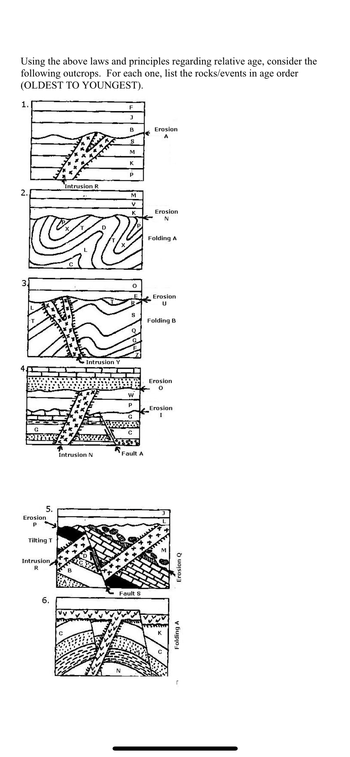
Applications and Investigations in Earth Science (9th Edition)
9th Edition
ISBN: 9780134746241
Author: Edward J. Tarbuck, Frederick K. Lutgens, Dennis G. Tasa
Publisher: PEARSON
expand_more
expand_more
format_list_bulleted
Question

Transcribed Image Text:Part 2: Understanding Steno's Laws of Stratigraphy
In order to understand a sequence of events in sedimentary geology, there are basic principles that Nicolas Steno (1669)
outlined that we still utilize today.
Define the following principles IN YOUR OWN WORDS:
30. Law of Original Horizontality-
31. Law of Original/Lateral Continuity-
32. Law of Superposition-
33- Law of Inclusion-
34-Law of Cross Cutting Relationships-
Expert Solution
This question has been solved!
Explore an expertly crafted, step-by-step solution for a thorough understanding of key concepts.
This is a popular solution
Trending nowThis is a popular solution!
Step by stepSolved in 3 steps

Follow-up Questions
Read through expert solutions to related follow-up questions below.
Follow-up Question
Follow up question from this previous questions about the laws

Transcribed Image Text:Using the above laws and principles regarding relative age, consider the following outcrops. For each one, list the rocks/events in age order (OLDEST TO YOUNGEST).
**1.**
Diagram 1 shows several horizontal layers labeled from oldest at the bottom to youngest at the top. The layers are intersected by an intrusion labeled "Intrusion R" and topped with an "Erosion A."
**2.**
Diagram 2 displays folded layers labeled with capital letters. The sequence includes "Folding A," indicating the folding event, and "Erosion N" at the top.
**3.**
Diagram 3 features horizontal layers with an intrusion labeled "Intrusion Y" cutting through them. An erosion surface labeled "Erosion U" caps the layers, which includes a folding event "Folding B."
**4.**
Diagram 4 presents various layers with a diagonal "Intrusion N" crossing through them. A fault labeled "Fault A" is also present, with two erosion surfaces "Erosion O" and "Erosion I."
**5.**
Diagram 5 illustrates tilted layers marked by "Tilting T," with an intrusion labeled "Intrusion R." Erosion surface "Erosion Q" and another "Erosion P" are depicted, along with a fault "Fault S."
**6.**
Diagram 6 consists of a folded pattern labeled "Folding A" and includes several distinct rock layers cut by an intrusion.
Each of these diagrams demonstrates the principles of relative dating, showing the sequence of events that affect the rock layers, including deposition, folding, faulting, intrusions, erosion, and tilting.
Solution
by Bartleby Expert
Follow-up Questions
Read through expert solutions to related follow-up questions below.
Follow-up Question
Follow up question from this previous questions about the laws

Transcribed Image Text:Using the above laws and principles regarding relative age, consider the following outcrops. For each one, list the rocks/events in age order (OLDEST TO YOUNGEST).
**1.**
Diagram 1 shows several horizontal layers labeled from oldest at the bottom to youngest at the top. The layers are intersected by an intrusion labeled "Intrusion R" and topped with an "Erosion A."
**2.**
Diagram 2 displays folded layers labeled with capital letters. The sequence includes "Folding A," indicating the folding event, and "Erosion N" at the top.
**3.**
Diagram 3 features horizontal layers with an intrusion labeled "Intrusion Y" cutting through them. An erosion surface labeled "Erosion U" caps the layers, which includes a folding event "Folding B."
**4.**
Diagram 4 presents various layers with a diagonal "Intrusion N" crossing through them. A fault labeled "Fault A" is also present, with two erosion surfaces "Erosion O" and "Erosion I."
**5.**
Diagram 5 illustrates tilted layers marked by "Tilting T," with an intrusion labeled "Intrusion R." Erosion surface "Erosion Q" and another "Erosion P" are depicted, along with a fault "Fault S."
**6.**
Diagram 6 consists of a folded pattern labeled "Folding A" and includes several distinct rock layers cut by an intrusion.
Each of these diagrams demonstrates the principles of relative dating, showing the sequence of events that affect the rock layers, including deposition, folding, faulting, intrusions, erosion, and tilting.
Solution
by Bartleby Expert
Knowledge Booster
Recommended textbooks for you
 Applications and Investigations in Earth Science ...Earth ScienceISBN:9780134746241Author:Edward J. Tarbuck, Frederick K. Lutgens, Dennis G. TasaPublisher:PEARSON
Applications and Investigations in Earth Science ...Earth ScienceISBN:9780134746241Author:Edward J. Tarbuck, Frederick K. Lutgens, Dennis G. TasaPublisher:PEARSON Exercises for Weather & Climate (9th Edition)Earth ScienceISBN:9780134041360Author:Greg CarbonePublisher:PEARSON
Exercises for Weather & Climate (9th Edition)Earth ScienceISBN:9780134041360Author:Greg CarbonePublisher:PEARSON Environmental ScienceEarth ScienceISBN:9781260153125Author:William P Cunningham Prof., Mary Ann Cunningham ProfessorPublisher:McGraw-Hill Education
Environmental ScienceEarth ScienceISBN:9781260153125Author:William P Cunningham Prof., Mary Ann Cunningham ProfessorPublisher:McGraw-Hill Education Earth Science (15th Edition)Earth ScienceISBN:9780134543536Author:Edward J. Tarbuck, Frederick K. Lutgens, Dennis G. TasaPublisher:PEARSON
Earth Science (15th Edition)Earth ScienceISBN:9780134543536Author:Edward J. Tarbuck, Frederick K. Lutgens, Dennis G. TasaPublisher:PEARSON Environmental Science (MindTap Course List)Earth ScienceISBN:9781337569613Author:G. Tyler Miller, Scott SpoolmanPublisher:Cengage Learning
Environmental Science (MindTap Course List)Earth ScienceISBN:9781337569613Author:G. Tyler Miller, Scott SpoolmanPublisher:Cengage Learning Physical GeologyEarth ScienceISBN:9781259916823Author:Plummer, Charles C., CARLSON, Diane H., Hammersley, LisaPublisher:Mcgraw-hill Education,
Physical GeologyEarth ScienceISBN:9781259916823Author:Plummer, Charles C., CARLSON, Diane H., Hammersley, LisaPublisher:Mcgraw-hill Education,

Applications and Investigations in Earth Science ...
Earth Science
ISBN:9780134746241
Author:Edward J. Tarbuck, Frederick K. Lutgens, Dennis G. Tasa
Publisher:PEARSON

Exercises for Weather & Climate (9th Edition)
Earth Science
ISBN:9780134041360
Author:Greg Carbone
Publisher:PEARSON

Environmental Science
Earth Science
ISBN:9781260153125
Author:William P Cunningham Prof., Mary Ann Cunningham Professor
Publisher:McGraw-Hill Education

Earth Science (15th Edition)
Earth Science
ISBN:9780134543536
Author:Edward J. Tarbuck, Frederick K. Lutgens, Dennis G. Tasa
Publisher:PEARSON

Environmental Science (MindTap Course List)
Earth Science
ISBN:9781337569613
Author:G. Tyler Miller, Scott Spoolman
Publisher:Cengage Learning

Physical Geology
Earth Science
ISBN:9781259916823
Author:Plummer, Charles C., CARLSON, Diane H., Hammersley, Lisa
Publisher:Mcgraw-hill Education,